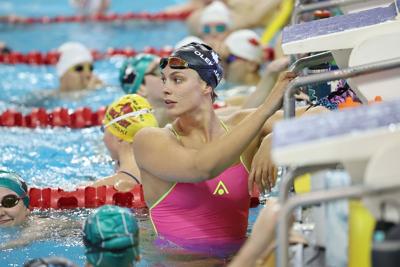Penny Oleksiak, CanadaÔÇÖs most decorated female Olympian, was looking to continue her comeback after a series of injuries and struggles to regain her love of swimming. But that road got a lot harder Friday with her announcement that she is involved in a ÔÇťwhereabouts caseÔÇŁ with World Aquatics.
Whereabouts violations are part of the world anti-doping rules but they are not evidence that an athlete has taken a performance-enhancing drug or that they have missed any tests. But the consequences can be just as severe as a doping violation.
What is a whereabouts case?
The World Anti-Doping Agency was created after Canadian sprinter Ben Johnson was stripped of his gold medal in the 100 metres at the 1988 Seoul Olympics for testing positive for an anabolic steroid, but the global system canÔÇÖt test everyone all the time.
Whereabouts rules essentially put elite athletes on notice that they could face a test any day and provides testers with the means to find them.
The world championships are set to begin July 11 and end Aug. 3 in Singapore.
Elite athletes like Oleksiak are required to report quarterly the times and locations of their regular activities, such as where they train, work and sleep and a specific hour and location every single day where they are guaranteed to be found.
Athletes often choose an hour in the morning or evening when they know theyÔÇÖll be at home. When their schedule changes or they travel for training and competition, sponsor’s engagements or a friendÔÇÖs wedding, they must update that information ahead of time.
There are two types of whereabouts problems: a filing failure, when athletes do not report on time or accurately where he they will be, and a missed test, which is a tester not being able to get a sample because athletes arenÔÇÖt where they said they would be. Both are considered equally serious.
If an athlete accumulates three failures in a 12-month period, that may constitute an anti-doping rule violation that carries a potential two-year ban from sport.
What do we know about OleksiakÔÇÖs case?
Not a lot. Her statement posted on social media said she is in the ÔÇťpreliminary stages,ÔÇŁ and her case ÔÇťdoes not involve any banned substances; itÔÇÖs about whether I updated my information correctly.ÔÇŁ
The 25-year-old ╔ź╔ź└▓ swimmer trains in Southern California and, over the past few months, has posted pictures of being at the Formula One race in Montreal, a sponsor engagement in Miami, the Coachella music and arts festival, and watching her brother play in the NHL. If, for example, any of those events conflicted with her whereabouts reporting, that could be the basis of a filing failure.
Why did she pull out of the 2025 world championships?
Oleksiak qualified for the world championships, which begin later this month in Singapore, by winning the 100 and 50 metre freestyle titles at the Canadian trials. She was expected to be a key relay swimmer.
She could have decided to compete. But, when an athlete is sanctioned, they lose the results they achieved during the time in question, so if Oleksiak had competed in the relays at the world championships, all the Canadians on that relay team or teams would be stripped of the result if she was sanctioned later.
With Oleksiak on the team, observers were pegging the Canadian womenÔÇÖs relay teams to place from third to fifth. There are still some medal chances but it will be more difficult without her.
What happens next?
When an athlete is notified about an apparent whereabouts failure, they have the opportunity to respond with an explanation and, if the initial decision doesn’t go their way, they can request a review.┬á
But this system isnÔÇÖt like a court of law where you are innocent until proven guilty. You are guilty until proven innocent in the sport anti-doping system.
Unless an athlete can show, for example, that the doping control officer made a mistake and they have GPS data from their phone proving they were where they said they would be, the best most athletes can expect with a good lawyer is a reduced sentence. 
The sanction for three whereabouts failures is a two-year ban. That can be reduced to one year depending on the athletes’ degree of fault.
As athletes and defence lawyers have noted for years, the legal framework around the anti-doping system is not one that gives athletes much benefit of the doubt and being fully exonerated is rare. 
Canadian Penny Oleksiak has qualified for the swim worlds, and the L.A. Olympics aren’t out of
As a comparison, the basic sentence for cases involving a banned substance is two years for a first offence, if the athlete can prove it wasnÔÇÖt intentional, such as ingesting the substance unknowingly in a supplement (with possible reductions beyond that), and four years if it is deemed intentional.
Sanctioned athletes arenÔÇÖt just banned from competition, theyÔÇÖre persona non grata within the sports system. They’re not allowed to train with other elite athletes or access services and support from their national sport organization. That adds to the challenge of returning to high-level competition after a sanction.
Has this happened to a Canadian swimmer before?
Yes, and recently. Tokyo Olympian Ruslan Gaziev received an 18-month sanction in 2024 for whereabouts failures and missed the Paris Olympics because of it.
He has just returned to competition and made the Canadian team for the upcoming world championships that Oleksiak will miss because of her whereabouts case.




























To join the conversation set a first and last name in your user profile.
Sign in or register for free to join the Conversation